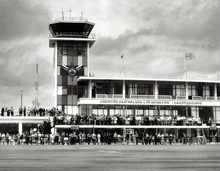Jodocus van Haltna Airfield: Difference between revisions
(Created page with "{{Infobox airport | name = Jodocus van Haltna Airfield | image = JVH luchthaven.jpg | code = JVH | SEN = | type = Regional and military Airport | owner-oper = Batavian Gov...") |
mNo edit summary |
||
| (3 intermediate revisions by the same user not shown) | |||
| Line 1: | Line 1: | ||
{{Batavia Article}} | |||
{{Infobox airport | {{Infobox airport | ||
| name = Jodocus van Haltna Airfield | | name = Jodocus van Haltna Airfield | ||
| image = JVH luchthaven. | | image = JVH luchthaven.png | ||
| code = JVH | | code = JVH | ||
| SEN = | | SEN = | ||
| Line 15: | Line 16: | ||
}} | }} | ||
The '''Jodocus van Haltna | The '''Jodocus van Haltna Airfield''', known in [[Batavia]]n as '''Jodocus van Haltna Luchthaven''', is a [[Batavia]]n airport and military airport, near the city of [[Caesterburgh]]. It was known as the ''[[Jodocus van Haltna International Airfield]]'' before 1686 AN. | ||
==History== | ==History== | ||
Before acting as main transport hub of independent Kasterburg, it acted as a minor airport to connect local flights between [[Caesterburgh]], [[Davignon]] and [['s Koningenwaarde]]. In 1660's it expanded, mostly | Before acting as main transport hub of independent Kasterburg, it acted as a minor airport to connect local flights between [[Caesterburgh]], [[Davignon]] and [['s Koningenwaarde]]. In 1660's it expanded, mostly meant to support the [[Luchtmobiele Brigade]]. Commercial flights increased in this period, along with the expansion of its military facilities. With the loss of the city's status of national capital, it reverted to local flights. Iron Company's assets (including [[Nakalma]]) were seized and the company banned, like it was in other parts of Batavia. | ||
The original runways were found to be unsuitable in 1685 AN, which led to a temporary closure of the airfield as a whole. The [[Batavian Revolution]] forced a reopening, with the Luchtmobiele Brigade taking priority over civil flights. Reconstruction, with a tight budget, led to a further decrease in interest of airlines in favour of [[Luchthaven Schapenheul]]. Newly paved runways were laid in preparation for accommodating new, mainly military, aircraft. At the same time new hangars were constructed. | The original runways were found to be unsuitable in 1685 AN, which led to a temporary closure of the airfield as a whole. The [[Batavian Revolution]] forced a reopening, with the Luchtmobiele Brigade taking priority over civil flights. Reconstruction, with a tight budget, led to a further decrease in interest of airlines in favour of [[Luchthaven Schapenheul]]. Newly paved runways were laid in preparation for accommodating new, mainly military, aircraft. At the same time new hangars were constructed. | ||
| Line 24: | Line 25: | ||
Confronted with the end of international travel, the airport lost its title ''international'', but kept offering flights between [[Davignon]] and [['s Koningenwaarde]]. | Confronted with the end of international travel, the airport lost its title ''international'', but kept offering flights between [[Davignon]] and [['s Koningenwaarde]]. | ||
==Security== | |||
The airport plays host to the Air Assault Regiment of the [[Luchtmobiele Brigade (Batavia)|Luchtmobiele Brigade]], whose assets contribute to the security of the site whilst in residence. The airport may also, in emergencies call upon additional ground forces from the Luchtmobiele Brigade, the majority of whose personnel are stationed at Hall Barracks nearby. | |||
[[Category:Batavia]] | [[Category:Batavia]] | ||
Latest revision as of 17:01, 27 November 2020
| Jodocus van Haltna Airfield | |||
|---|---|---|---|

| |||
| Code: JVH | |||
| Summary | |||
| Airport type | Regional and military Airport | ||
| Owner/Operator | Batavian Government | ||
| Serves | Caesterburgh, Batavia | ||
The Jodocus van Haltna Airfield, known in Batavian as Jodocus van Haltna Luchthaven, is a Batavian airport and military airport, near the city of Caesterburgh. It was known as the Jodocus van Haltna International Airfield before 1686 AN.
History
Before acting as main transport hub of independent Kasterburg, it acted as a minor airport to connect local flights between Caesterburgh, Davignon and 's Koningenwaarde. In 1660's it expanded, mostly meant to support the Luchtmobiele Brigade. Commercial flights increased in this period, along with the expansion of its military facilities. With the loss of the city's status of national capital, it reverted to local flights. Iron Company's assets (including Nakalma) were seized and the company banned, like it was in other parts of Batavia.
The original runways were found to be unsuitable in 1685 AN, which led to a temporary closure of the airfield as a whole. The Batavian Revolution forced a reopening, with the Luchtmobiele Brigade taking priority over civil flights. Reconstruction, with a tight budget, led to a further decrease in interest of airlines in favour of Luchthaven Schapenheul. Newly paved runways were laid in preparation for accommodating new, mainly military, aircraft. At the same time new hangars were constructed.
Confronted with the end of international travel, the airport lost its title international, but kept offering flights between Davignon and 's Koningenwaarde.
Security
The airport plays host to the Air Assault Regiment of the Luchtmobiele Brigade, whose assets contribute to the security of the site whilst in residence. The airport may also, in emergencies call upon additional ground forces from the Luchtmobiele Brigade, the majority of whose personnel are stationed at Hall Barracks nearby.